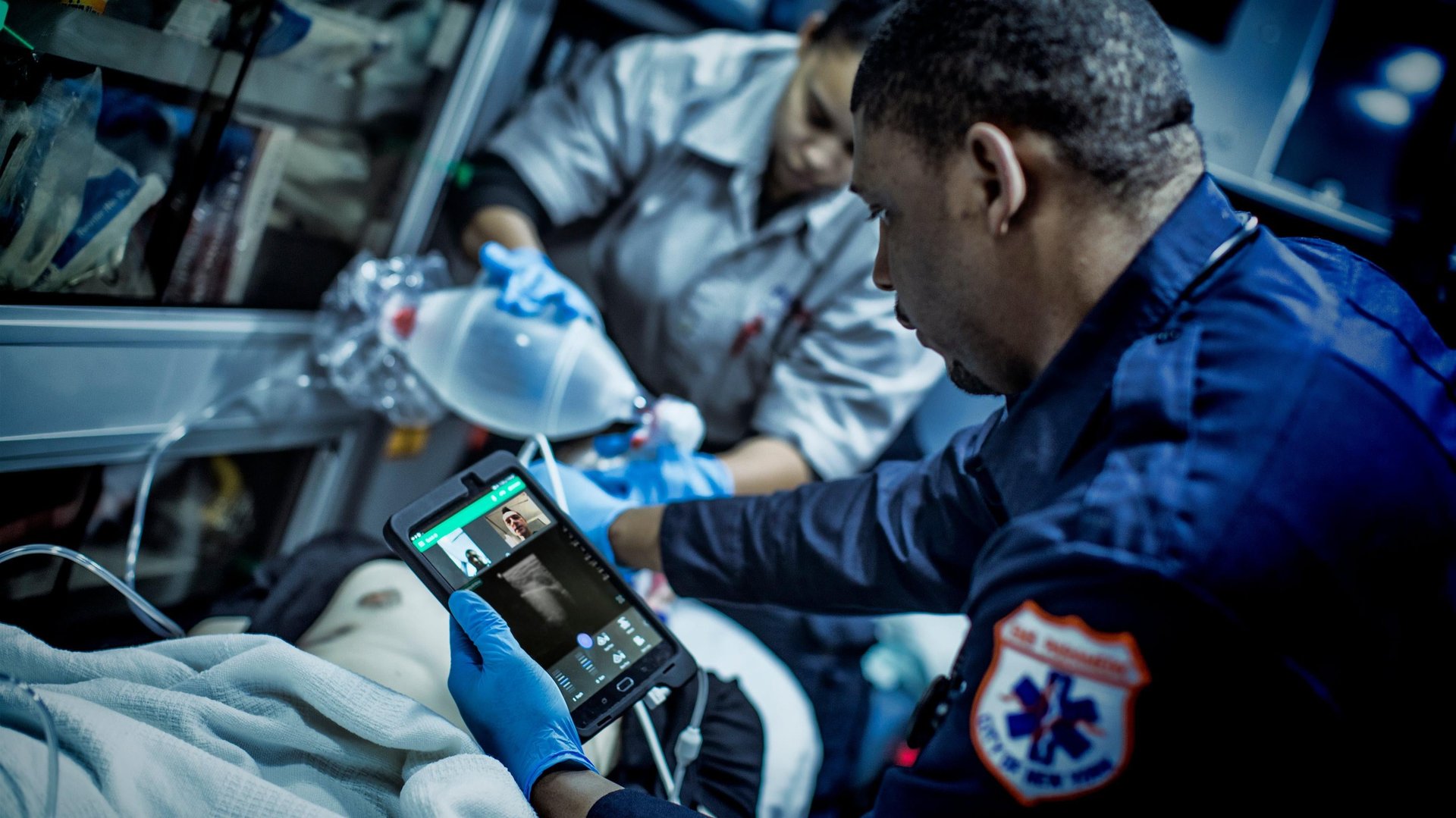What cloud technology has done for healthcare—and what more it can do
Philips innovation chief Shez Partovi sees the promise (and limits) of healthcare's cloud revolution

From advances in precision medicine to the simple convenience of booking doctors’ appointments online, cloud computing is transforming healthcare.
Few people have had a view into these innovations like Shez Partovi. A neuroradiologist in clinical practice from 1998 to 2013, he led business development for healthcare, life sciences, and medical devices at Amazon’s AWS cloud computing division before joining Philips, the Dutch health and consumer care conglomerate, in 2021 as chief medical, innovation, and strategy officer.
Despite rapid advances in cloud technology, says Partovi, medicine hasn’t kept pace. (For that, we can mostly blame the messy economics of healthcare, particularly in the US with its byzantine system of private health insurance and perverse incentives for investment.)
Partovi recently spoke with Quartz about how cloud technology is already producing better outcomes for care providers and patients, and how else it can help. The following transcript has been lightly edited for length and clarity.
QZ: You started in the field as a clinician. What are the biggest changes the cloud has already brought to healthcare for doctors and hospitals?
SP: We can start with diagnostics and the power of performing medical imaging at incredibly high speeds with abilities that previously were not possible. So, for example, doing a scan in half the time and getting this amazing resolution. Or sequencing a virus and identifying the exact genome sequence in 48 hours—that’s also a cloud computing success story.
And from the patient’s perspective?
From a patient lens, healthcare was so far behind that some of the cloud’s advantages don’t seem exciting, like online scheduling. If you go back even five years, there was slim pickings in terms of how you could do this. But it goes beyond that. Just think about the chat bots, the virtual telehealth, and apps that can help to predict your asthma attack. These are all based on the fact that cloud technology has provided a place where you can centralize data, perform all kinds of analytics or have machine learning models, and then provide personalized experiences to patients. Really, one of the main things that cloud technology is enabling is personalized healthcare.
What do you mean by personalized healthcare?

When you think of processing genomic data, combined with medical imaging data, combined with electronic medical records data, to give a very specific potential path of care for a single individual, that is also enabled by cloud technology.
But I think the most significant thing that really has come forward, and in no small part also because of the pandemic, is operational forecasting. So you can gather all the data, bring them together in a cloud environment, build machine learning models that create predictions, and then put those back into workflow.
We have a solution called patient flow capacity suite, which predicts patient flow to the hospital—they’re here now, your intensive care volume is this, it’s likely going to be that tomorrow, the length of stay is likely to be this—all these predictions help administrators run the hospital more effectively, more efficiently.
Leaving aside for a minute the question of the innovations to come, is healthcare using all of the cloud technology that’s available to it today?
When you think of the quadruple aim in healthcare —to improve quality, reduce cost, improve the clinician experience, and improve patient health—and then tie that back to how the cloud enables that, we’ve not even begun to scratch the surface of the things we can do. If we were to walk through the hospital today, literally every 10 feet we could point to a workflow that could be optimized with some sort of machine learning and algorithm.
I look at other industries like entertainment and gaming and what they’ve been able to really tap into. Of course, the economics are different. One of the great challenges we face in healthcare is this complexity where those who benefit from the advances of cloud technology aren’t necessarily the ones that are paying for it, and so this causes an inherent headwind to rapid adoption. As an industry, you have to figure out the economics of any tool you bring forward. That doesn’t exonerate the cloud providers from what they have to do to push forward. But we have a long way to go.
What progress could we be seeing in healthcare today if we had the will to invest in it?
Let’s look at bedside patient monitors. So today there’s a device that sits there and shows the patient’s blood pressure, oxygenation, and so on. And that’s data visualization.
What really helps improve quality of care, and reduce cost, is if the machine is using all that data to predict things for the clinician. So, for example, what is the likelihood that patient is going to come off the ventilator in the next 12 hours? What is the likelihood they’re going to need a ventilator in the next couple of hours? What’s the likelihood they’re going to develop an infection?
The metaphor I use is—well, where are you based?
I’m in New York.
Okay. So if I gave you 10 years of New York weather data on your iPhone, that is not nearly as useful for you as just the umbrella icon or sunshine icon. The clinician is looking at the equivalent of 10 years of weather data and trying to figure out if the patient is likely to be discharged.
We’ve been doing this in the intensive care unit for years, predicting if a patient is going to have an instability over the next 12 to 24 hours, for instance. But that’s in a very specific setting. I once was walking in a hospital with a chief operating officer and she said, “Shez, I don’t need you tell me what’s happening in my ER today. Can you tell me what’s going to happen in my ER next Friday?”
At the end of the day, the tech is all there. But it’s procuring the data, cleansing the data, building the models, putting it back into devices, getting regulatory approval, getting it in the hands of the customers—those are the kinds of things where we have lots of opportunity to improve quality and reduce cost.
Why wouldn’t the healthcare industry be investing more in this if the outcomes are so much more efficient and presumably lower cost? It seems that hospitals and insurance companies, not to mention governments, should be racing to install this stuff.
You used a really key word just now: outcomes. So when we’re working to validate the claim that this algorithm we’re building for these monitors actually will make sure the patient does better and reduce the cost, the claim has to be supported before it can get FDA clearance. So we have to build the model, do the studies, demonstrate the value, and then put it in the device. That’s one reason for the lag time to innovation. The arc is not as long as with drug discovery, but it’s long.
And then there’s the economics. So let’s assume I create an algorithm that gives nudges that will help a patient lose weight over the next five years. Well, [a lot of US] patients change health insurance every year. If I’m going to pay for this app that helps you lose 10 pounds over the next five years, I’m probably not really going to benefit because you’re going to be off my plan in a year. So at least in the US, there is literally a first-mover disadvantage. If everybody does it, we’re good. But the first mover wants bulletproof outcomes.
What about the technological challenges?
We have large data payloads. Imaging? Massive payloads. Genomics? Very large payloads. These data payloads have to move from on-premise, which is where you get an MRI scan or where you had genomic sequencing done, to the cloud, and it’s got to get there quickly. So it’s not just the cloud providers [involved]; it’s telecom providers, cable providers.
When you look at how we can innovate, we are finding sometimes we hit this glass ceiling. Given the imaging prowess that we have with MRI scanners, CT scanners, and other equipment, the payloads are big and we want to use more cloud technology. But how do we get it there, and not at exuberant cost?
What’s your dreamiest scenario for things we can do on the healthcare and consumer care front, if the cloud keeps innovating the way we think it might?
When I dream, I dream on behalf of my customers. And when we listen to our customers, there are two areas in which they’re asking for innovation that involves the cloud. One is a desire for remote care. Now, in a hospital, you’ve got an IT department, a local area network, all of that is locked in. As you try to move care to the home, you start depending on sensors and wearables and the cloud because your IT system doesn’t go to the patient’s home.
There’s one other area that is really, really dependent on cloud as well. And it’s the hardware that we sell today—an MRI scanner, a CAT scanner. You deliver that scanner, and after a few years the hospital might have to upgrade it and they might have to buy a new scanner. Customers keep asking us, ‘How can I just buy it from you and then just over the air you update it?’
It’s kind of the Tesla model. It can be updated without needing a forklift, and that is enabled by the cloud. Today, one of our handheld ultrasound devices, Lumify, is that way. It’s a device, a handheld ultrasound scanner, but we can update it over the cloud. Now imagine a whole MRI scanner like that. Those are the kinds of directions, when I think blue-sky, that I think of, enabled by the cloud.
